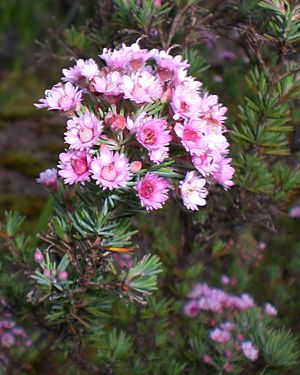Plumed featherflower facts for kids
Quick facts for kids Plumed featherflower |
|
|---|---|
 |
|
| V. plumosa on Mount Melville | |
| Scientific classification | |
| Genus: |
Verticordia
|
| Species: |
plumosa
|
| Varieties | |
|
See text |
|
The Plumed Featherflower, also known as Verticordia plumosa, is a beautiful flowering plant. It belongs to the myrtle family, called Myrtaceae. This plant only grows naturally in the south-west part of Western Australia. It was the very first type of Verticordia plant ever discovered and described. This plant is a shrub with long, thin leaves. It has lovely, scented flowers that grow in round clusters. These flowers can be pink, purple, or white. Sadly, two kinds of this plant are now considered "threatened," meaning they are at risk.
Contents
What the Plumed Featherflower Looks Like
The Plumed Featherflower is usually a shrub with branches that spread out. It can grow up to about 1.4 metres (4.6 feet) tall. Its leaves are long and thin, like lines. They are also somewhat rounded when you look at them from the side. These leaves can be from 1.5 to 14 millimetres (0.06 to 0.55 inches) long.
The flowers of this plant smell nice. They grow in round clusters or flat-topped groups. Each flower sits on a small stalk, which is about 1.5 to 11 millimetres (0.06 to 0.43 inches) long. The bottom part of the flower, called the floral cup, looks like half a sphere. It is smooth but has tiny hairs.
The sepals are like small leaves that protect the flower bud. They are pink, purple, or white. They are 1.5 to 5 millimetres (0.06 to 0.20 inches) long and spread out wide. They have 3 to 7 feathery parts, which is why the plant is called "Plumed Featherflower." The petals are similar in colour to the sepals. They are shaped like an oval or an egg and are 2 to 4.5 millimetres (0.08 to 0.18 inches) long. At first, they spread out, but later they turn upwards. The style, which is part of the flower's reproductive system, is 4.5 to 8 millimetres (0.18 to 0.31 inches) long. It is curved and has hairs near its tip. The time when the plant flowers depends on its specific type, or variety.
Naming the Plumed Featherflower
This plant was first officially described in 1839 by a scientist named René Louiche Desfontaines. He first gave it the name Chamelaucium plumosum. This description was published in a science journal. Later, in 1917, another scientist named George Druce changed its name to Verticordia plumosa. This new name was published in a report from a botanical club.
The name plumosa comes from a Latin word, pluma, which means "feather." This name was chosen because of the feathery look of the flower's sepals.
Scientists have found different types, or varieties, of Verticordia plumosa. Some of these varieties include:
- Verticordia plumosa var. plumosa
- Verticordia plumosa var. ananeotes
- Verticordia plumosa var. brachyphylla
- Verticordia plumosa var. grandiflora
- Verticordia plumosa var. incrassata
- Verticordia plumosa var. pleiobotrya
- Verticordia plumosa var. vassensis
There is also a special type called 'Eric John'. Scientists think it might be a mix of V. plumosa and another plant called Chamelaucium floriferum.
Where the Plumed Featherflower Grows
The Plumed Featherflower mostly grows in areas close to the coast. You can find it from the Arrowsmith River all the way to places east of Esperance. However, one specific type, called intercrassa, grows further inland. This variety can be found near towns like Newdegate and Hyden.
Protecting the Plumed Featherflower
Two types of the Plumed Featherflower, ananeotes and vassensis, are considered "Threatened Flora." This means they are rare and need special protection. The Western Australian Government's Department of Parks and Wildlife works to protect these plants.


